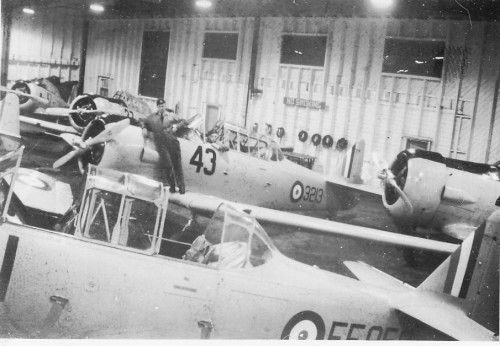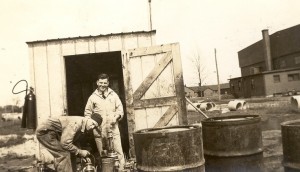
Photo courtesy of Geoff Redman who returned to live in Lakefield, Ontario.

Standing: Bob Fidler
Flares are prepared for lighting the runways for night flying.
Bob Fidler recalled one night while on ambulance duty when a call came through.
“The most serious accident I attended had a happy ending. I was on night duty in the medical centre with ambulance. It consisted of one medical orderly plus one room in the living quarters plus a phone. We got a call in the early hours saying there was a crash on the drome. We drove across to where the plane was on fire on the outer boundary of the fence. It meant we had to go out of the camp while the crash tender crew cut through the fence.”
Mr. Edgar McCalpin, whose farm was in Pittsburgh Township and one of those that bordered the airport, arrived on the scene very quickly. Fortunately, LAC Wm. E. Billings of Iroquois, Ontario, had been sitting on a portion of the fence near the back of the airfield and arrived shortly after Mr. McCalpin. He released the canopy and pulled the pupil, C.P.O. Lawrence Blackburn, of Coventry, England, from his burning plane. Mr. McCalpin assisted him.
Continuing the story, Bob said: “By his actions he saved the sailor concerned from death. We put him on a stretcher with the orderly doing what he could, the arrangement being that Dr. Davis would be informed by phone. He met us at the post office, took one look at the pupil who had serious burns, and said: ‘Kingston General as quickly as possible’. When we arrived at Kingston you would not have given much for his chances of survival.”
The pilot, whose clothes were on flame when rescued, suffered multiple burns and scalp lacerations when his plane struck the tree. The Chief Petty Officer, who had arrived with Course 61, resumed training after a full recovery and graduated with Course No. 68.